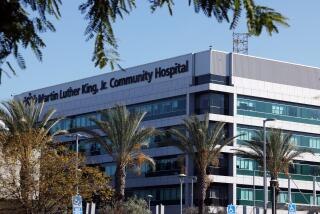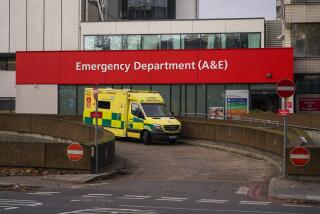Overflow in Many U.S. Hospitals, Study Finds
- Share via
WASHINGTON — At least 90% of large U.S. hospitals with more than 300 beds operate at or over capacity for treating patients and sometimes have to divert ambulances to other hospitals, a survey reported Monday.
The finding suggests that many emergency rooms are unable to handle even the day-to-day stresses, let alone any big emergencies, experts say.
A chronic shortage of nurses, growing piles of paperwork and legions of uninsured people who use emergency rooms as their personal doctors are all contributing to the mess, according to the survey, which was done for the American Hospital Assn.--which lobbies for increased federal funding and other priorities--and the American College of Emergency Physicians.
“As we speak, hundreds of patients throughout the country are in the hallways of emergency departments waiting for a hospital bed,” said Dr. Brent Asplin, an emergency room doctor in St. Paul, Minn., and a spokesman for the emergency physicians’ group.
The survey found that six out of 10 hospitals nationwide are filled to capacity. The larger the hospital, the worse the problem, the survey found. One in three are so crowded that ambulances are sometimes diverted to other hospitals, the survey found.
The situation will only get worse as the population ages, hospital association executive vice president Rick Pollack said.
“At the same time when patients’ needs are increasing, the nation’s hospitals are facing a severe shortage of key hospital workers and soaring costs of the goods and services they need to do their jobs for their communities,” he said.
The group did not blame the for-profit health-care system and the growing dominance of managed care. “Only 14% of the nation’s hospitals are for-profit,” said Carmela Coyle, director of policy for the hospital association.
But she said state-federal health insurance programs did not pay enough to cover treatment for the poor and the elderly. “The Medicare program pays less than the cost of caring for a patient on Medicaid,” she said.
Hospitals also cannot keep enough staff on the payroll. “There are more than 168,000 unfilled positions, of which 75% are for registered nurses,” the association said in a statement.
The 40 million people who lack health insurance add to the burden, coming to the emergency room for every minor ailment or, worse, waiting until they are seriously ill.
Overcapacity problems appear to be most acute in New England, where 52% of hospitals say they are operating beyond capacity, and on the West Coast, where 44% reported the same.
The survey, conducted by the Lewin Group, included 1,501 hospitals, or 36% of American hospitals with emergency departments. Demographically, participating hospitals appeared to be representative of all U.S. hospitals, the hospital association said.
More to Read
Sign up for Essential California
The most important California stories and recommendations in your inbox every morning.
You may occasionally receive promotional content from the Los Angeles Times.










